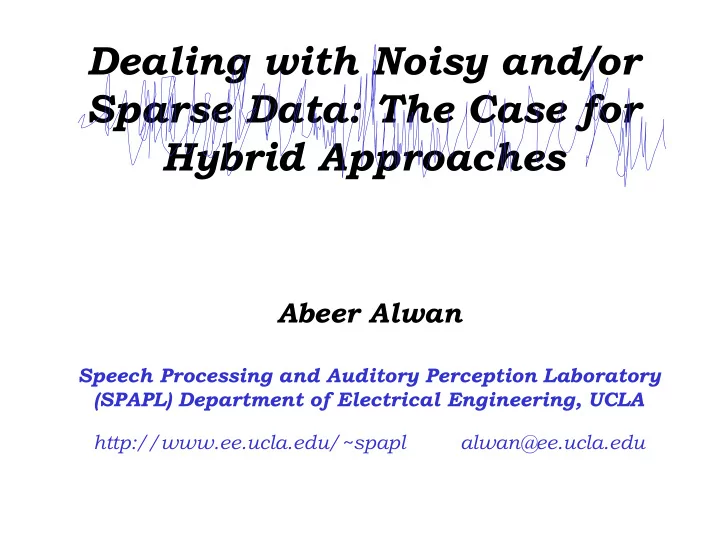

Dealing with Noisy and/or Sparse Data: The Case for Hybrid Approaches Abeer Alwan Speech Processing and Auditory Perception Laboratory (SPAPL) Department of Electrical Engineering, UCLA http://www.ee.ucla.edu/~spapl alwan@ee.ucla.edu
Key Argument for Hybrid Approaches in Speech Processing: Variability • The variability in the way humans produce speech due to, for example, gender, accent, age, and emotion necessitates data-driven approaches to capture significant trends/behavior in the data. • The same variability, however, may not be modeled adequately by such systems especially if data are limited and/or corrupted by noise.
Projects (last 5 years) Hybrid Statistical Modeling and Knowledge- Based Approach to Improve: -rapid speaker normalization (including kids speech) -cross-language adaptation -height estimation -noise robust ASR Speech Production Modeling -modeling the voice source by using high- speed imaging Bird Song and Species Identification Funding sources in the last 5 years: NSF, DARPA, and industry.
Challenges in ASR of Kids ’ Speech • Lack of large databases of children ’ s speech • Significant intra- and inter-speaker variability • Significant variability in pronunciations due to different linguistic backgrounds, and misarticulations • Low signal-to-noise ratio in the classroom • Distinguishing reading errors from pronunciation differences
Effect of Age on Resonances Adult male: 8-year old boy saying vowel /uw/ the same vowel Children have shorter vocal tracts, and hence higher resonances. More variability than adults. Less control of articulators. Higher Pitch.
Pronunciation Modeling • Knowledge-based hypothesis – Acoustic phonetic knowledge transfer • Linguistic Hypotheses regarding consonants: • /v/ /f/ (very) • /z/ /s/ (those) Mapping English Acoustically similar • /dh/ /d/ Phoneme Spanish Phonemes • /th/ /t/ • /r/ /rr/: word initial Think position • /y/ /jh/ • /s/ /z/ Listen • Unaspirated /p/, /t/, /k/: Produce word initial position
Using subglottal resonances for speaker ID and speaker normalization (2010-2015) • The subglottal system is practically time invariant unlike the supraglottal vocal tract. – Can potentially characterize a speaker better, or at least provide complementary information. 3000 3000 3000 Frequency (Hz) Frequency (Hz) Frequency (Hz) 2000 2000 2000 green dots: formants 1000 1000 1000 red dots: SGRs 0 0 0 0 0 0 400 400 400 800 800 800 1200 1200 1200 1600 1600 1600 Time (ms) Time (ms) Time (ms)
Height estimation: evaluation • Training data: SGRs and heights of 50 speakers. • Evaluation data: speech signals of 604 speakers. Using Sg1 Using Sg2 Ganchev et al . mean abs. error 5.3 cm 5.4 cm 5.3 cm RMS error 6.6 cm 6.7 cm 6.8 cm • Main advantages of the proposed algorithm: – Only 1 feature (Sg1 or Sg2), as opposed to 50 vocal-tract features for Ganchev et al . – Very little training data (50 speakers vs. 468). (Speech Communication, 2013 )
Concept of Correlogram-based Time-Freq Domain Pitch Estimation Filtered Correlogram time waveform High Freq. Short-Time AutoCorr. Speech Short-Time AutoCorr. : : Low Freq. Averaged across channels : : Auditory Filterbank Summary Correlogram (2010-2014) 9 9
Variance and Invariance in Speech Quality • Data collected in collaboration with the Linguistics department and Medical school • Inter-speaker variability – Day/time variability (session variability) – Read speech vs. conversational speech – Low-affect speech vs. high-affect speech • Recordings – Steady-state vowel /a/ (3 repetition) – Reading sentences – Explaining something to someone they do not know – Phone call to someone they know – Telling something unimportant/ joyful/ annoying – Speaking to pets 10
Research Directions • Analysis and recognition of kids ’ speech (including longitudinal studies) • Studies of the role of articulatory/linguistic features in speech processing (human and machine) • Studies of natural emotions (not acted) • Human and Machine Recognition in naturally-noisy data • Analysis and recognition of disordered speech • Articulatory data: ultrasound, MRI, EMMA, high-speed imaging • Accented speech
Evaluating Proposals/Ideas at Academic Institutions • Academic research should be exploratory in nature and the source of creative ideas which may or may not lend itself to immediate practical success.
Subglottal Resonances • Subglottal features are useful for: (1) height estimation, (2) speaker normalization for ASR, (3) speaker identification, and (4) cross-language adaptation. – Effective with limited data. – Robust to environmental noise. Collaborative research with psychology and speech science.
Recommend
More recommend